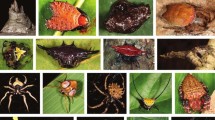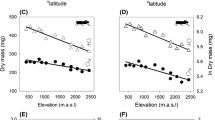Abstract
Fecundity selection has been hypothesized to drive the evolution of female gigantism in the orb-weaving family Nephilidae. Several species of these spiders also exhibit large amounts of variation in size at maturity in one or both sexes. In this article, we attempt to detect correlations of mean and variation in adult size at a phylogenetic scale between the sexes and with latitude. We tested six predictions derived from three broad developmental, ecological, and age structure hypotheses, using independent contrasts and a recent species-level nephilid phylogeny as well as least squares and other conventional statistics: 1. In both sexes, species with larger mean size will have greater variation in size; 2. Males and females will show correlated changes in mean size and of variation in size; 3. In both sexes, mean size will be negatively correlated with the midpoint of the latitudinal range; 4. In both sexes, tropical species will be more variable; 5. In both sexes, more widespread species will be more variable; 6. Variation in male size will be positively correlated with mean female size. In no cases were male and female development correlated, suggesting that in this lineage male and female body size evolve independently. The only significant trend detected was a positive phylogenetic correlation between variation in female size and latitude, the opposite of prediction 4. Power tests showed that in all tests of the ecological hypothesis, sample sizes were more than adequate to detect significant trends, if present. Our results suggest that evolutionary trends in juvenile development among species are too weak to be detectable in such data sets.



Similar content being viewed by others
References
Christenson TE, Goist KC (1979) Costs and benefits of male-male competition in the orb-weaving spider, Nephila clavipes. Behav Ecol Sociobio 5:87–92
Christenson TE, Brown SG, Wenzel PA, Hill EM, Goist KC (1985) Mating behavior of the golden-orb-weaving spider, Nephila clavipes: I. Female receptivity and male courtship. J Comp Psych 99:160–166
Coddington JA (1994) The roles of homology and convergence in studies of adaptation. In: Eggleton P, Vane-Wright RI (eds) Phylogenetics and ecology. Academic Press, London, pp 53–78
Coddington JA, Hormiga G, Scharff N (1997) Giant female or dwarf male spiders? Nature 385:687–688
Darwin C (1871) The descent of man, and selection in relation to sex. John Murray, London
Dawkins R (1980) Good strategy or evolutionarily stable strategy? In: Barlow GW, Silverberg J (eds) Sociobiology: beyond nature/nurture?. Westview Press, Boulder, pp 331–367
Dudycha JL (2003) A multi-environment comparison of senescence between sister species of Daphnia. Oecologia 135:555–563
Felsenstein J (1985) Phylogenies and the comparative method. Am Nat 125:1–15
Foellmer MW, Moya-Laraño J (2007) Sexual size dimorphism in spiders: patterns and processes. In: Fairbairn DJ, Blanckenhorn WU, Szekely T (eds) Sex, size and gender roles: evolutionary studies of sexual size dimorphism. Oxford University Press, Oxford, pp 71–81
Garland T, Ives AR (2000) Using the past to predict the present: confidence intervals for regression equations in phylogenetic comparative methods. Am Nat 155:346–364
Garland T Jr, Midford PE, Ives AR (1999) An introduction to phylogenetically based statistical methods, with a new method for confidence intervals on ancestral states. Am Zool 39:374–388
Head G (1995) Selection on fecundity and variation in the degree of sexual size dimorphism among spider species (Class Araneae). Evolution 49:776–781
Higgins LE (1992) Developmental plasticity and fecundity in the orb-weaving spider Nephila-clavipes. J Arachnol 20:94–106
Higgins L (1993) Constraints and plasticity in the development of juvenile Nephila clavipes in Mexico. J Arachnol 21:107–119
Higgins L (2000) The interaction of season length and development time alters size at maturity. Oecologia 122:51–59
Higgins L (2002) Female gigantism in a New Guinea population of the spider Nephila maculata. Oikos 99:377–385
Higgins L, Goodnight C (2010) Nephila clavipes females have accelerating dietary requirements. J Arachnol 38:150–152
Higgins LE, Rankin MA (1996) Different pathways in arthropod postembryonic development. Evolution 50:573–582
Higgins LE, Rankin MA (2001) Mortality risk of rapid growth in the spider Nephila clavipes. Func Ecol 15:24–28
Hormiga G, Scharff N, Coddington JA (2000) The phylogenetic basis of sexual size dimorphism in orb-weaving spiders (Araneae, Orbiculariae). Sys Bio 49:435–462
Kuntner M (2005a) Systematics and evolution of nephilid spiders (Araneae, Nephilidae new rank). George Washington University, Washington, DC
Kuntner M (2005b) A revision of Herennia (Araneae, Nephilidae, Nephilinae), the Australasian “coin spiders”. Invert Syst 19:391–436
Kuntner M (2006) Phylogenetic systematics of the Gondwanan nephilid spider lineage Clitaetrinae (Araneae, Nephilidae). Zool Scr 35:19–62
Kuntner M (2007) A monograph of Nephilengys, the pantropical ‘‘hermit spiders’’ (Araneae, Nephilidae, Nephilinae). Syst Entomol 32:95–135
Kuntner M, Coddington JA (2009) Discovery of the largest orbweaving spider species: the evolution of gigantism in Nephila. PLoS ONE 4(10):7516. doi:10.1371/journal.pone.0007516
Kuntner M, Coddington JA, Hormiga G (2008) Phylogeny of extant nephilid orb-weaving spiders (Araneae, Nephilidae): testing morphological and ethological homologies. Cladistics 24:147–217
Kuntner M, Coddington JA, Schneider JM (2009) Intersexual arms race? Genital coevolution in nephilid spiders (Araneae, Nephilidae). Evolution 63:1451–1463
Lande R (1980) Sexual dimorphism, sexual selection, and adaptation in polygenic characters. Evolution 34:292–307
Maddison WP, Maddison DR (2009) Mesquite: a modular system for evolutionary analysis. Version 2.6. http://mesquiteproject.org
Midford PE, Garland Jr T, Maddison WP (2007) PDAP: PDTREE Package of Mesquite, Version 1.11. http://mesquiteproject.org/pdap_mesquite/
Miyashita T (1986) Growth, egg-production, and population-density of the spider, Nephila clavata in relation to food conditions in the field. Res Pop Ecol 28:135–149
Miyashita T (1991) Direct evidence of food limitation for growth rate and body size in the spider Nephila clavata. Acta Arachnol 40:17–21
Mousseau TA, Roff DA (1989) Adaptation to seasonality in a cricket: patterns of phenotypic and genotypic variation in body size and diapause expression along a cline in season length. Evolution 43:1483–1496
Nylin S, Gotthard K (1998) Plasticity in the life-history traits. Ann Rev Entom 43:63–83
Nylin S, Gotthard K, Wiklud C (1996) Reaction norms for age and size at maturity in Lasiommata butterflies: predictions and tests. Evolution 50:1351–1358
Pigliucci M, Cammell K, Schmitt J (1999) Evolution of phenotypic plasticity a comparative approach in the phylogenetic neighbourhood of Arabidopsis thaliana. J Evol Biol 12:779–791
Pollard H, Cruzan M, Pigliucci M (2001) Comparative studies of reaction norms in Arabidopsis. I. Evolution of response to daylength. Evol Ecol Res 3:129–155
Richter-Boix A, Llorente GA, Montori A (2006) A comparative analysis of the adaptive developmental plasticity hypothesis in six mediterranean anuran species along a pond permanency gradient. Evol Ecol Res 8:1139–1154
Robinson MH, Robinson B (1973) Ecology and behavior of the giant wood spider Nephila maculata (Fabricius) in New Guinea. Smithson Contrib Zool 149:1–73
Roff DA (1980) Optimizing development time in a seasonal environment: the ‘ups and downs’ of clinal variation. Oecologia 45:202–208
Roff DA (1983) Phenological adaptation in a seasonal environment: a theoretical perspective. In: Brown VK, Hodek I (eds) Diapause and life cycle strategies in insects. Springer, New York, pp 253–270
Roff DA (2002) Life history evolution. Sinauer Associates, Massachusetts
Schneider JM (1997) Timing of maturation and the mating system of the spider, Stegodyphus lineatus (Eresidae): how important is body size? Biol J Linn Soc 60:517–525
Schneider JM, Elgar MA (2005) The combined effects of pre- and post-insemination sexual selection on extreme variation in male body size. Evol Ecol 19:419–433
Schoener TW, Janzen DH (1968) Notes on environmental determinants of tropical versus temperate insect size patterns. Am Nat 102:207–224
Slatkin M (1984) Ecological causes of sexual dimorphism. Evolution 38:622–630
Snedecor GW, Cochran WG (1989) Statistical methods. Blackwell Publishing, Oxford
Sultan SE (2001) Phenotypic plasticity for fitness components in Polygonum species of contrasting ecological breadth. Ecology 82:328–343
Sultan SE, Wilczek AM, Hann SD, Brosi BJ (1998) Contrasting ecological breadth of co-occurring annual Polygonum species. J Ecol 86:363–383
Toft S (1976) Life-histories of spiders in a Danish beech wood. Nat Jutlandica 19:5–40
Toft S (1983) Life cycles of Meta segmentata (Clerck 1757) and Meta mengei (Blackwall 1869) in western Europe (Arachnida: Araneae: Tetragnathidae). Verhandlungendes Naturwissenschaftlichen Vereins in Hamburg 26:265–276
Uhl G, Vollrath F (2000) Extreme body size variability in the golden silk spider (Nephila edulis) does not extend to genitalia. J Zool 251:7–14
Van Buskirk J (2001) A comparative test of the adaptive plasticity hypothesis: relationships between habitat and phenotype in anuran larvae. Am Nat 160:87–102
Vollrath F (1980a) Why are some spider males small? A discussion on Nephila clavipes. In: Gruber J (ed) Verhandlungen. 8. Internationaler Arachnologen—Kongress abgehalten ander Universitat fur Bodenkultur Wien. H. Egermann, Vienna, pp 165–169
Vollrath F (1980b) Male body size and fitness in the web-building spider Nephila clavipes. Z Tierpsychol 53:61–78
Vollrath F (1998) Dwarf males. TREE 13:159–163
Vollrath F, Parker GA (1992) Sexual dimorphism and distorted sex ratios in spiders. Nature 360:156–159
Vollrath F, Parker GA (1997) Reply to ‘Giant female or dwarf male spiders?’. Nature 385:688
Acknowledgements
We are grateful to many people for help in the preparation of this manuscript, especially numerous patient curators. Financial support during the collection of data and preparation of the manuscript came from the US National Science Foundation with grants to LEH (INT-1235778) and JC (PEET grant DEB-9712353 and EAR-0228699), from the Slovenian Research Agency to MK and JC (ARRS grants Z1-7082-0618, BI-US/06-07-026) and the European Commission’s 6th FP to MK (MIRG-CT-2005 036536). From the Smithsonian NMNH, D. DeRoche helped with the specimen management and K. Darrow prepared all the figures. Specimen measurements and data entry were done in part by M. Gregorič (Ljubljana) and A. Gallant Bernstein, J. Madden, R. Webber, B. Mulcahey and S. Wanamaker at UVM. Additional data were graciously contributed by J. Schneider, M. Elgar, and H. Japyassu. T. Garland and P. Midford helped us navigate the intricacies of PDAP within Mesquite. Conversations with K. Pickett also aided in our understanding of the statistics employed in these analyses. Comments from several anonymous reviewers were very helpful in preparation of the final manuscript.
Author information
Authors and Affiliations
Corresponding author
Rights and permissions
About this article
Cite this article
Higgins, L., Coddington, J., Goodnight, C. et al. Testing ecological and developmental hypotheses of mean and variation in adult size in nephilid orb-weaving spiders. Evol Ecol 25, 1289–1306 (2011). https://doi.org/10.1007/s10682-011-9475-9
Received:
Accepted:
Published:
Issue Date:
DOI: https://doi.org/10.1007/s10682-011-9475-9




